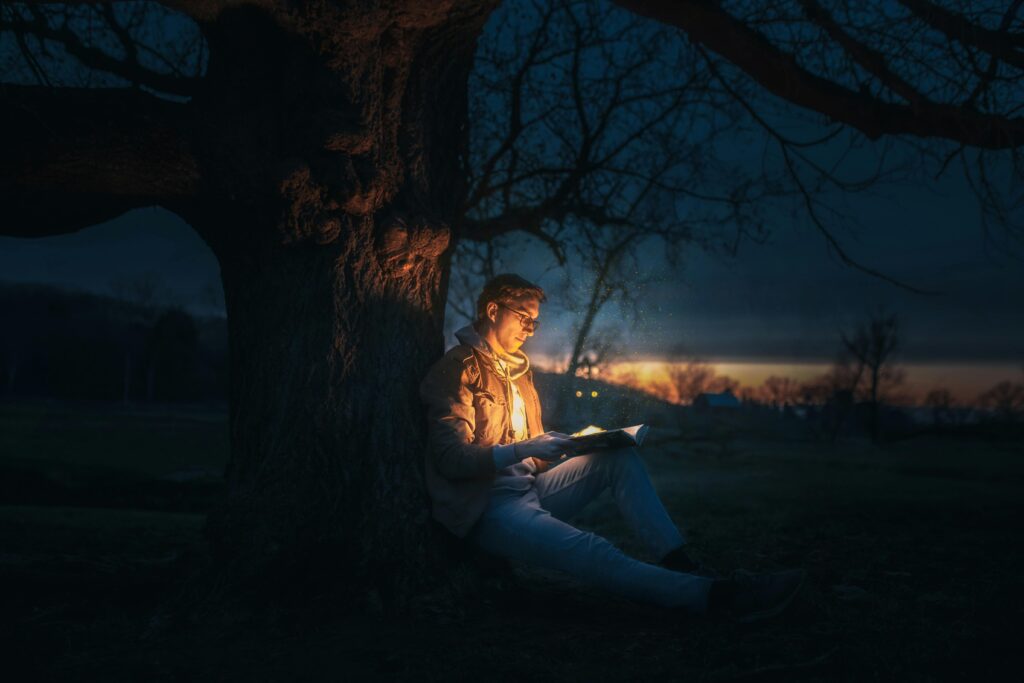Writing
5 Worldbuilding Exercises for Science Fiction and Fantasy
In most genres, once you have the story, the setting suggests itself. In the science fiction and fantasy genres, however, the setting often comes first.
It would have been impossible for Tolkien to write The Lord of the Rings without first deciding if there was magic and figuring out some of the history of Middle Earth. While many authors would argue that the extent of worldbuilding Tolkien did was far from necessary, putting your core worldbuilding concepts in place is nevertheless essential.
In this article, we provide five creative writing exercises to help you develop worldbuilding story ideas for fantasy and sci-fi. Rather than simple writing prompts, these exercises are designed to entice original story ideas from your own imagination. By completing them, you will gain an understanding of how to create a fascinating world with unique characters.
What is worldbuilding?
“I think that the joy of worldbuilding in fiction is honestly the joy of getting to play god.”
Neil Gaiman
Worldbuilding is choosing all the ingredients for the setting and history of your story. It is the deciding of the physical and metaphysical traits, plus the important historical events that have shaped its culture and influence the events unfolding in your writing.
There is no need to build an entire world. By researching or inventing some facts in detail, you will create the illusion that you know your whole world inside out. The world is there to support your characters and your plot. This is what readers ultimately care about. However, your plot can’t occur in a vacuum (except in outer space, of course), which is where worldbuilding comes into play.
Your world might be entirely fictional (like all but one planet in The Hitchhiker’s Guide to the Galaxy by Douglass Adams), based on myth (like the Discworld series by Terry Pratchett), or be exactly like Earth, but with a few tweaks (like Harry Potter). Regardless, it’s up to you to know the laws that govern your world and the events that shape who your characters are.
If you find yourself spending too long on worldbuilding, here are five worldbuilding exercises to help you along with your next project:
1. Parallel dimensions
“In a parallel universe, you and I could be more than just a story.”
Unknown
An interdimensional portal has been discovered. As you step through it, a new realm, at first indistinguishable from our own, awaits you. But more portals exist. Do you stay in this new dimension, or continue onwards, exploring realms that are ever more exotic and varied than our own?
The differences are vast – they might allow you to time travel, visit fantasy realms, or distant planets. Perhaps you will find diamonds littering the ground around you, magical artefacts, or knowledge of a future not yet experienced on Earth. Or you might uncover a danger that could pursue you back to your home.
Spend three minutes describing a dimension similar to our own. What one or two differences are there? These might be differences in physics, society, technology, etc.
Pass your dimension to another writer if working as a group or continue if working solo. Spend four minutes describing the next dimension out where things get weirder. What new dangers and opportunities await?
After four minutes, pass your dimension on again. Spend five minutes describing the next dimension out. In this reality things have changed completely. Take previous changes to their extreme and describe what the new dimension is like.
If working as a group, on completing the third dimension, form small groups and describe your final dimensions to each other. Do you think these worldbuilding ideas could be the basis for a good story, with or without the portals?

2. Reduced gravity
“To build your world, start by creating the physical environment where your culture and story will take place, from the planetary level to a specific location. Then add the “Element X” that will affect everything.”
N. K Jemisin
What if there was less gravity? Not so much so that we would float away or leave Earth a barren wasteland but enough to make a difference. How would this affect the landscape, evolution, and social dynamics?
Think about that for a moment before continuing the exercise.
If the world was lighter, winds would be stronger, mountains taller and it would be easy to build giant structures that remain sturdy. Insects and birds could grow bigger, meaning birds would be more intelligent. A flying creature might become the dominant species, rather than the human race. This species would migrate and be able to travel easily, meaning there’d be less genetic variety. This would make race wars less likely unless it was between completely different species.
As the creatures evolved, they would develop a different social hierarchy. Resources over where to lay eggs could become precious. They’d develop their own value system and have unique sports, clothing (if any), art, and literature.
Write a story set on this alien planet. Think about the consequences and repercussions of this one small change. How does it impact everyday life?
Is there an Element X you could use to inspire your own story?
3. Magic systems
“He reeked of magic. When I looked into his eyes, remnants of power flickered there. No kindness, none of the wry humor and gentle reprimands. The Tamlin I knew was gone.”
Sarah J. Maas, A Court of Thorns and Roses
In nearly every fantasy novel, magic has a price. Whether it’s the lure of the ring, physical weakness, or the risk of losing yourself entirely. This counterbalances the limitless power magic might otherwise bring.
Some books, like The Lord of the Rings by JRR Tolkien use soft magic systems. As a reader, we don’t really know what Gandalf can and cannot do. This adds tension and surprise to the story. Others, like The Mistborn Series by Brandon Sanderson use hard magic with predictable results. This allows the reader to understand the limitations and consequences of a sorcerer’s abilities more readily. A final option is magical realism, where you introduce subtle elements of magic into an otherwise ordinary setting.
Either as a group or individually, brainstorm different effects magic might have. This could be individual spells, or entire categories of magic like necromancy or alchemy. Decide what the most powerful spell a legendary sorcerer could cast is and write it down.
Next, decide how to limit your magic. What happens when you overuse it, or what risk do you incur every time you use it? Brainstorm possible risks and consequences and write these down in a separate list.
Finally, choose one spell and one risk. Spend ten minutes writing a scene where your hero tries to replicate the spell of a famous sorcerer and fails. Consider what drove them to attempt it and how this failure impacts their body, mind, and soul.

4. Urban fantasy writing exercise
“Urban fantasy does what it says on the tin; it’s a genre of literature where fantasy is set against what can be considered an urban backdrop or a fantasy story that is set in a city or suburb.”
Jacqueline Silvester
Imagine a temple in an urban fantasy story. This could be in a city here on Earth, in outer space, or in a parallel dimension.
Brainstorm different characters and what their motivations might be for entering the temple. If you’re working as a group, share them with each other. If you’re completing this writing exercise by yourself, brainstorm some ideas before reading on.
Here are a few suggestions for characters and their motivations:
- A farmer who is praying to have their crops saved.
- A monk who uses magic and pretends it’s divine.
- A space pirate who has discovered the temple and decided to loot it.
- A detective investigating a murder.
Spend five minutes writing a story of your character entering the temple from one of the above perspectives. Now spend five minutes writing the same scene from a different perspective.
Ask yourself what each character would focus on. What would they notice and what would they ignore? How does the building make them feel? Show this by their thoughts, sensations and through body language.
5. Creating characters that fit into your world
“You just write characters who are different from each other. They look different from each other, they feel different from each other… You’re holding the reader’s hand a little bit, and you’re making sure that they’re never confused.”
Neil Gaiman, “The Art of Storytelling” Masterclass
Once you’ve created the outlines of a unique world, you need unique characters to fit into it. In this writing exercise, you will create four characters who feel like they belong, while at the same time being unique.
Coming up with ideas for names
Naming a character well is essential, however names will sometimes come to you after you’ve begun your story. Decide whether you want to go for an exotic or everyday name for each character.
Exotic names:
- Severus Snape
- Luke Skywalker
- Neo (an anagram of one)
- Aslan (Turkish for lion)
Everyday names to show an ordinary person is doing the extraordinary:
- Sarah Connor
- John McClane
To generate names, try any of the following:
- Read text backwards or start in the middle of a word and ignore spaces. See if you discover something that sounds like an actual name.
- Brainstorm a list of characteristics you associate with each person. Then use Google Translate or DeepL to translate them into multiple languages. Experiment and see if any of the words lend themselves to names. If your story has alien races, consider using the same language or similar variants of it for different characters in each race.
- Use a random name generator.
Creating authentic characters
What’s your world like? If it’s a harsh place where lightning scorches the earth and mythical creatures lurk behind every rock, waiting to eat you, it’s unlikely a happy-go-lucky character who’s always daydreaming will have survived. Or if they have, it’s due to their ever-watchful friend or bodyguard.
Ensure their personalities fit the world, either complimenting it, or contrasting with it for a reason you can explain. Then develop your character’s values, clothing and so on, in keeping with their cultural background and family history.
Developing your own worldbuilding ideas
The above worldbuilding writing exercises are designed to encourage you to develop your imagination and reflect on what’s important, not just for worldbuilding but for your story as a whole.
Use them to develop your own story ideas, then start writing! As your novel or short story advances, you will have plenty of opportunities to refine the world and embellish upon its history. Unlike real life, things don’t need to happen chronologically and if you think of a great idea for your setting, you can always edit your story after the first draft to add it.
Need more inspiration? Try out the eighteen creative writing exercises you can find here or these five character creation writing games.